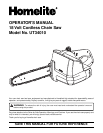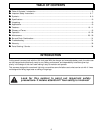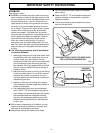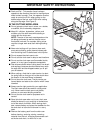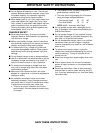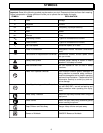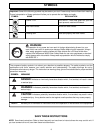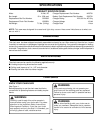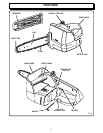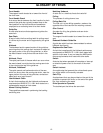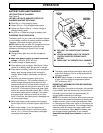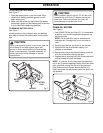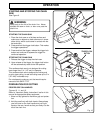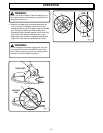
7
b. That extension cord is properly wired and in
good electrical condition; and
c. That wire size is large enough for AC ampere
rating of charger as specified below:
Cord Length (Feet) 25' 50' 100'
Cord Size (AWG) 16 16 16
NOTE: AWG = American Wire Gage
■ Do not operate charger with a damaged cord or
plug. If damaged, have replaced immediately by a
qualified serviceman.
■ Do not operate charger if it has received a sharp
blow, been dropped, or otherwise damaged in any
way; take it to a qualified serviceman.
■ Do not disassemble charger; take it to a qualified
serviceman when service or repair is required.
Incorrect reassembly may result in a risk of electric
shock or fire.
■ To reduce risk of electric shock, unplug the
charger from outlet before attempting any mainte-
nance or cleaning. Turning off controls will not
reduce this risk.
■ Disconnect charger from power supply when not in
use.
■ Risk of electric shock. Do not touch uninsulated
portion of output connector or uninsulated battery
terminal.
■ Save these instructions. Refer to them frequently
and use them to instruct others who may use this
unit. If you loan someone this unit, loan them these
instructions also.
■ Do not dispose of batteries in a fire. The cell may
explode. Batteries should be recycled, consult your
local waste authority for information regarding
available recycling and/or disposal options.
■ When battery pack is not in use, keep it away from
other metal objects like: paper clips, coins, keys,
nails, screws, or other small metal objects that can
make a connection from one terminal to another.
Shorting the battery pack terminals together may
cause sparks, burns, or a fire.
CHARGER SAFETY
■ Save these instructions. This manual contains
important Rules for Safe Operation and operating
instructions for charger.
■ Before using battery charger, read all instructions
and cautionary markings in this manual, on battery
charger, and product using battery charger.
■ To reduce risk of injury, charge only nickel-cad-
mium type rechargeable batteries. Other types of
batteries may burst, causing personal injury and
damage.
■ Do not expose charger to wet or damp conditions.
■ Use of an attachment not recommended or sold by
the battery charger manufacturer may result in a
risk of fire, electric shock, or injury to persons.
■ To reduce risk of damage to charger body and
cord, pull by charger plug rather than cord when
disconnecting charger.
■ Make sure cord is located so that it will not be
stepped on, tripped over, or otherwise subjected to
damage or stress.
■ An extension cord should not be used unless
absolutely necessary. Use of improper extension
cord could result in a risk of fire and electric shock.
If extension cord must be used, make sure:
a. That pins on plug of extension cord are the
same number, size and shape as those of plug
on charger.
SAVE THESE INSTRUCTIONS
IMPORTANT SAFETY INSTRUCTIONS



